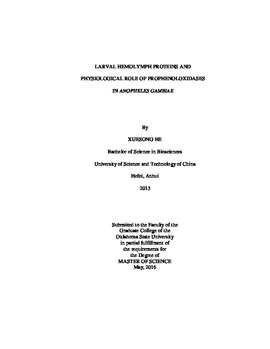| dc.contributor.advisor | Jiang, Haobo | |
| dc.contributor.author | He, Xuesong | |
| dc.date.accessioned | 2017-02-22T22:14:58Z | |
| dc.date.available | 2017-02-22T22:14:58Z | |
| dc.date.issued | 2016-05-01 | |
| dc.identifier.uri | https://hdl.handle.net/11244/49085 | |
| dc.description.abstract | The African mosquito Anopheles gambiae is one of the major vectors for human malaria. Understanding its immune system may provide new means for disrupting the disease transmission. While the Drosophila melanogaster and Manduca sexta immune systems are well studied, most components ofthe mosquito system remain to be examined. Insect hemolymph contains important factors for humoral and cellular defense responses as well as immune signal transduction, including pattern recognition receptors, serine proteases, serpins, antimicrobial peptides. In the present study, we collected hemolymph samples from water- and E. coli-pricked A. gambiae larvae. The samples were separated on SDS-PAGE and subjected to LC-MS/MS analysis. The detected peptides were searched against A. gambiae proteins from VectorBase. We have identified a total of 1,756 proteins.Most of the abundant proteins contain putative signal peptides. Twenty-five most abundant proteins represent over half of the total protein amount, 109 proteins are up-regulated, 49 are down-regulated, and 235 are considered to be defense-related. After examining the protein distribution in the gel slices, we found that more abundant proteins tend to exist in more of the slices. We also obtained evidence for proteolysis, post-translational modification, serpin-protease complex formation, and high Mr immune complex formation based on the distribution data. In addition to the proteomic study, we generated monoclonal antibodies against prophenoloxidases PPO2 and PPO7 and found that PPO2 is presented in the adult hemolymph. Lastly, we tried to knockdown PPO gene expression in female adults by injecting double-stranded RNA and examined their survival following an E. coli challenge. No significant difference was observed between the test and control groups. | |
| dc.format | application/pdf | |
| dc.language | en_US | |
| dc.rights | Copyright is held by the author who has granted the Oklahoma State University Library the non-exclusive right to share this material in its institutional repository. Contact Digital Library Services at lib-dls@okstate.edu or 405-744-9161 for the permission policy on the use, reproduction or distribution of this material. | |
| dc.title | Larval Hemolymph Proteins and Physiological Role of Prophenoloxidases in Anopheles Gambiae | |
| dc.contributor.committeeMember | Noden, Bruce | |
| dc.contributor.committeeMember | Soulages, Jos� Luis | |
| osu.filename | He_okstate_0664M_14478.pdf | |
| osu.accesstype | Open Access | |
| dc.description.department | Entomology & Plant Pathology (MS) | |
| dc.type.genre | Thesis | |
| dc.type.material | text | |
